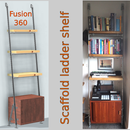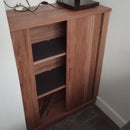Introduction: Bread Bin - Lockdown Style
So I've been wanting to make a bread bin for a while now but I have been putting it off as I needed to go to the timber yard to get some supplies.
To put this in context it's currently April 2020 in the UK and we are currently in our third week of lockdown due the Coronavirus, so going to buy new wood would either be not possible or irresponsible. I am currently working from home too so I am able to start work earlier, with no commuting, so have an additional couple of spare hours in the afternoons due to being able to finish early.
Therefore my only way of making something that requires quite a bit of wood is to make the wood planks myself from offcuts.
I have added this in to the woodworking contest so please vote if you have found it interesting.
So down to it....
Supplies
Materials
Wood off cuts - lots of
Two bolts for the hinge
Glue
Tools
Multiple saws - I used a table saw, miter saw and a band saw. One of these would do the job too.
Clamps
Drill
Sander
Planer thicknesser / jointer planer
Step 1: Off Cuts - Lots of Off Cuts
So having being woodworking for several years I have loads of small off cuts. I have been saving then up for outdoor fires and the such but haven't got round to it yet. So I have loads which needed using, this seemed like a good use for them.
Step 2: Preparing the Off Cuts
This is the first of two laborious stages. I used the band saw to cut my off cuts to a uniform square section and a mitre saw to make the ends of each off cut square to the faces.
I screwed a back fence to my mitre saw to increase accuracy and reduce tear-out. It was also easy to see how much you were about to saw off which helped to keep each piece as long as possible.
In the end I cut around 300 pieces to make all the boards required to make the bread bin. I did this in stages as I progressed through the project, as after cutting 100 you think you'll have enough. You don't!
Step 3: Board Making Jig and Making a Board
I made a simple jig out of a couple of bits of timber screwed at right angles on a piece of MDF so I had a nice square edge and a flat surface to work to.
I started with the first layer just gluing the ends of each block and then for the next layers I glued the one long edge and the ends. After a few layers I put a strip of plywood along the top edge and clamped for a couple of hours - the plywood helps with keeping pressure from the clamps uniform across the length of the board.
The strength of the board will come from the glued edges of the off cuts rather than the ends.
Step 4: Filling and Planing
Once a board was to the correct size I planed and thicknessed (jointed and planed) it and the filled most of the gaps with wood filler. I did however leave any big gaps, which were from imperfections in the wood or even one which had part of a hole for a biscuit. I thought these would add to the look and tell a story about the construction of the board.
One the filler was dry I sanded the filler layer off and refilled any gaps as required.
Step 5: Cutting the Sides of the Bread Bin
As I wanted the door of the bread bin to swing down from a hinge at the bottom I wanted the front face to be sloped backwards so the door didn't just open under gravity.
I rotated the mitre saw until it looked visually correct which ended up being around 9 degrees, and cut the front edges of the side panels. This is the stage where you decide which part of the panel is the top and bottom.
Step 6: Planning the Joinery
I decided to use mortise and tenon joints to hold the whole thing together, so planned on where I wanted to put all the mortises.
I wanted the bottom to be slightly raised from the bottom of sides and the door to be placed slightly behind the front edges of the sides, so marked the mortises and cut the bottom board to size.
As you may have noticed I used plywood for the base. I thought that this wasn't going to be seen much anyway and I'd had enough of making boards out of off cuts by that time!!
Step 7: Cutting the Joints
So I started with the mortises on the end panels first on the router table, cutting incremental deep until around half the thickness. the length of the mortise was shorter than the top and bottom panels as I was using a hidden mortise and tenon joint - I find you need to be less accurate for this method which just makes things a little easier.
The tenons were then cut to the bottom board. When cutting these joints just increase the cut depth slowly and keep checking the fit until they fit nice and snug.
While I was doing this the top board was being made. As this was a wide board I made this in two sections and glued these bit together to make it wide, while keeping it flat. This board was all prepared I cut the joints as I did for the bottom board.
Once all the joints were cut I sawed the ends of the tenons off to get them to the same width as the mortise.
As the bottom board was plywood I decided to add some thin off cuts along the cut front edge to keep it similar to the rest of the bread bin. I just glued and 'clamped' them in place with tape.
Step 8: Preparing the Door
Next I dry fitted the edges, top and bottom and held them together with a clamp. Now everything was at it's final size and position I could prepare the door to size and position. The door was going to hinge around a couple of bolts to the bottom which went through the edge panels and into the door itself.
I placed the bottom of the door at the same level as the underside of the bottom board and determined the location of the holes. I drilled the hole in the side panels on a drill press and the holes to the door with a hand drill. As the long drill hole to the door is quite close to three edges I had to dill that quite slowly and keep checking I was drilling vertically in all directions. It seemed to work well though!
I then tested the position of the door to the dry fitted bread bin with the bolts.
Step 9: Routing the Door and Edges
In order for the door to open I needed to add a radius to the back edge. I used an ogee bit in the router table to cut the radius. Once cut I tested the door and it was perfect as it was so didn't need to do any additional work to that edge. I also added a small curve to the front edge of the lid so it could open further that at right angles to the front slope. I then cut the door to size and also added a curve to the top.
I then swapped to a 45deg router bit and added a bevel to the front and top edges of the side panels.
The back panel is made of hardboard that will be nailed in to the back, so I added a recess along the back edges of the panels for the back panel to sit in.
I then sanded all the panels to 180 grit and glued and clamped the sides, top and bottom.
Step 10: Fitting the Door
I didn't want the hinge to be seen so I cut the top of the bolt off so I could hammer it below the surface and fill the gap with a dowel.
I mixed up some epoxy and put some in to the drill hole in the door. I then fitted the door and drove the bolt down below the surface using another bolt and hammer. One it was dried I filled the hole with a dowel, cut and sanded it flush.
I then made a small handle from the part I cut off from the top of the door. This meant that it already had a sloped edge to it so I only needed to sand and screw it in place. I did adjust the thickness of the handle so the lid was horizontal when fully open.
I then nailed the back panel on.
Step 11: Finished
Lastly I oiled the bread bin in a couple of layers of food safe oil and it was all finished.
All I needed to do then was to fill it with bread.
I am very pleased with the final result and recommend this technique for making your own boards, that is if you have enough time and patience as it is a very time consuming and laborious process. Perfect for a lockdown!!!!
Thanks!

Participated in the
Woodworking Contest











